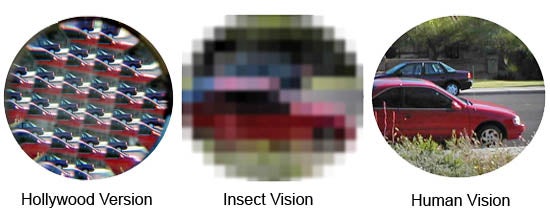Do Insects Really See Hundreds of Tiny Identical Images?
A Hollywood Misconception - You’ve seen it in the movies: as insects fly through our homes they see hundreds of tiny screens, all showing the same picture. Why would an insect need to see one image multiplied by a hundred? As it turns out, insects DO NOT see a kaleidoscope of multiple images. Ants see only one picnic basket, bees see only one hive, and mosquitoes see only one warm body. Insects do have multiple lenses that take in light from their surroundings. After this light is transformed into electrical energy, it all travels to the same place to be processed, the insect brain. Here this visual information is combined and forms just one image that allows the insect to make decisions based on its surroundings.
What do insects see? How can we imagine what insects see? Well, let’s try with what’s in front of you right now, a computer screen. Computer screens are made up of tiny color squares called pixels. When you combine millions of these pixels, they form an image on your computer, perhaps a game or picture of your favorite pet. Adding more pixels for a given area improves the quality of the picture you see; it becomes crisper and clearer. Now try this exercise: stand an arm's length away from your computer, looking at your computer screen. Imagine the screen as it is, only made up of pixels the size of a pea. Through the eyes of an insect, these words would blur together into one big, dark column onscreen, surrounded by white stripes. What would a car look like to passing insect?

To learn more, visit our page on the colors animals see and take a look at how a butterfly is likely viewed by a human and another butterfly.
Additional images from Wikimedia.
Read more about: Did You Know Butterflies Are Legally Blind?
Bibliographic details:
- Article: Hollywood Misconception
- Author(s): Dr. Biology
- Publisher: Arizona State University School of Life Sciences Ask A Biologist
- Site name: ASU - Ask A Biologist
- Date published:
- Date accessed:
- Link: https://askabiologist.asu.edu/content/bugvision-hollywood-misconception
APA Style
Dr. Biology. (). Hollywood Misconception. ASU - Ask A Biologist. Retrieved from https://askabiologist.asu.edu/content/bugvision-hollywood-misconception
Chicago Manual of Style
Dr. Biology. "Hollywood Misconception". ASU - Ask A Biologist. . https://askabiologist.asu.edu/content/bugvision-hollywood-misconception
Dr. Biology. "Hollywood Misconception". ASU - Ask A Biologist. . ASU - Ask A Biologist, Web. https://askabiologist.asu.edu/content/bugvision-hollywood-misconception
MLA 2017 Style

Scanning electron microscope picture of a compound eye. The color has been added to highlight the eye.
Be Part of
Ask A Biologist
By volunteering, or simply sending us feedback on the site. Scientists, teachers, writers, illustrators, and translators are all important to the program. If you are interested in helping with the website we have a Volunteers page to get the process started.

